Did you know that poor project planning is a leading cause of failure in software development? According to the Harvard Business Review, 1 in 6 IT projects has a cost overrun of 200% and a schedule overrun of 70%.
This highlights the critical importance of thorough project planning. For startup founders and decision-makers, an important part of this planning is understanding and evaluating your software development vendor‘s statement of work (SoW), a document that outlines the scope, timelines, and responsibilities of a software project.
But what exactly should you look for in a SoW to ensure your project’s success?
This blog post explains everything you need to know about SoW in software development and offers practical advice on evaluating your potential provider’s SoW, so you can make informed decisions.
What is a statement of work (SoW) in software development?
SoW stands for statement of work. SoW meaning in software development is a document that clearly outlines key details such as the project scope, specific tasks to be completed, expected deliverables, and the overall timeline. This document also details the project’s objectives, the responsibilities of each party, milestones to be achieved, and the standards to be met by the development team. Essentially, the software development statement of work guides all aspects of the project from start to finish.
Who uses the statement of work (SoW)?
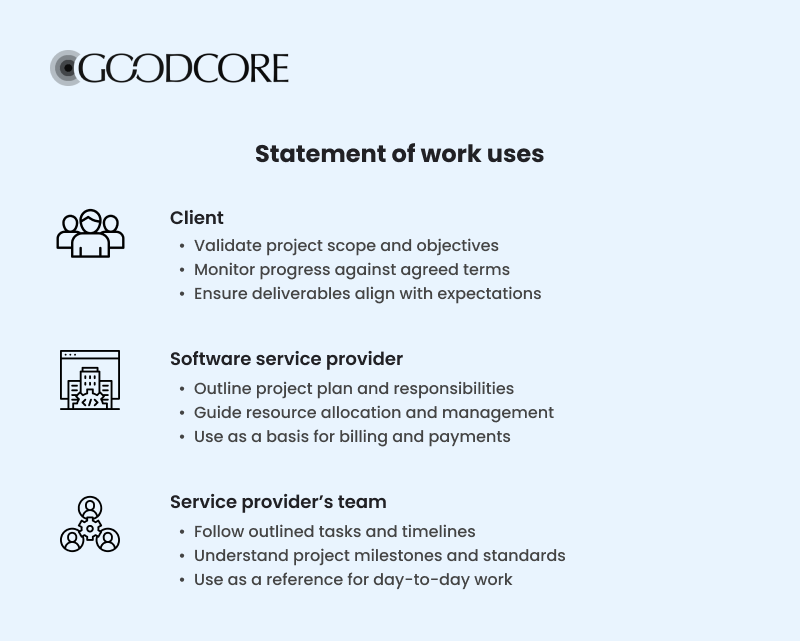
Statement of work is an important business document for both the parties – you as the decision maker and the software service provider.
SoW helps you understand what to expect in terms of project deliverables, timelines, and costs. You can use the document to plan your schedules, allocate budget, and synchronise with other related business activities.
On the other hand, the service provider relies on the SoW as a guideline for what needs to be delivered. It helps them plan resources, manage their team’s workload, and align their efforts with the client’s expectations.
In addition, the project manager, software developer, and quality assurance teams of the service provider also use the software development statement of work. It guides them throughout the project lifecycle, serving as a reference point for project goals, timelines, and standards to be met.
Read also: Core phases of agile software development lifecycle
Who prepares the SoW for software development?
In most cases, your software development vendor will prepare the SoW document. They have the technical know-how to outline the project’s scope, timelines, and resource needs.
However, as a client, your involvement in shaping the statement of work is crucial. You provide the essential details like your project’s vision, objectives, and specific requirements. Your input ensures that the SoW aligns with your business goals and expectations.
For example, at GoodCore Software, our solutions team comprising the CEO, VP of engineering, and project manager prepares the statement of work after a series of initial consultations with the client. We have an internal SoW template for software development that helps us deliver an in-depth SoW document for our clients.
How SoW keeps your budget and timelines in check
Now you’ve got a good grasp on the basics of SoW for software development, let’s see how it helps to keep your project on time and within budget.
- Detailed cost breakdown: The statement of work provides a comprehensive breakdown of all project costs, including development, labour, materials, and any other expenses. This clear cost structure helps prevent unexpected expenses.
- Payment schedules: It outlines the payment schedule, tying payments to milestones or specific deliverables. This not only assists in budget management but also ensures that work is progressing as planned.
- Change order management: The statement of work usually includes procedures for managing change orders. If the software development scope changes, these procedures detail how additional costs will be estimated and approved, preventing uncontrolled increases in the budget.
- Detailed schedule and milestones: The statement of work outlines the project timeline, including start and end dates, and sets key milestones. This schedule provides a roadmap for the project and helps ensure that all parties are aligned on timing expectations.
- Deadline enforcement: By establishing clear deadlines for deliverables, the statement of work serves as a commitment from the service provider to complete specific tasks by certain dates, which helps in maintaining the overall project timeline.
- Progress monitoring: The payment schedule and milestones in the statement of work can be used to monitor progress. Regular reviews against these benchmarks enable early detection of delays or deviations from the plan, allowing for timely interventions.
SoW, work order, service agreement and more – Here’s what all that means
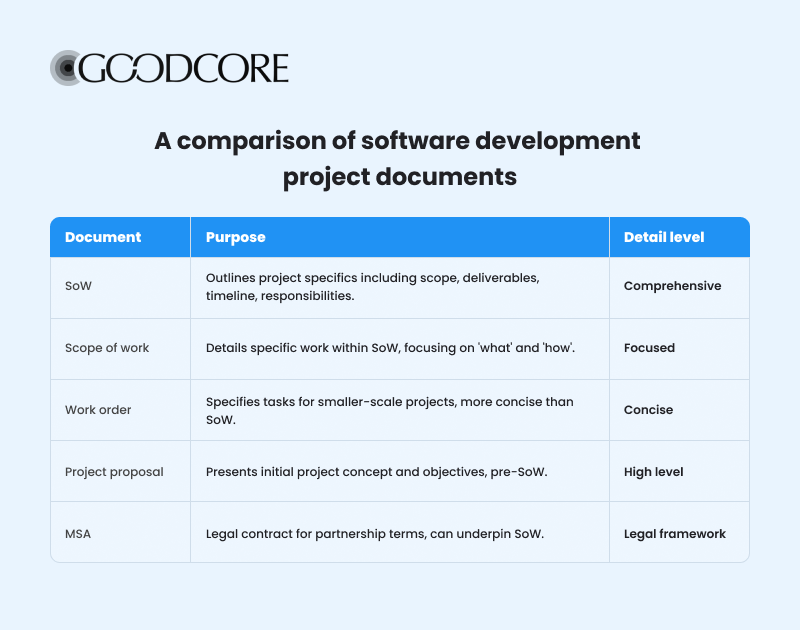
You might hear various terms from service providers related to project documentation, and it can be confusing to differentiate between them. Here’s a quick rundown of what the different industry terms mean and how they interconnect:
- Statement of work: This is a detailed document that outlines the specifics of a software project. It covers the scope of work, deliverables, timeline, and responsibilities.
- Scope of work: This is a section often found within the SoW that specifically details the work that will be performed. It’s a more focused part of the SoW, zeroing in on the ‘what’ and ‘how’ of the project.
- Work order: Often used in more transactional or smaller-scale projects, a work order outlines the specific work to be done. It’s typically more concise than a comprehensive SoW.
- Project proposal: Before the SoW, you might receive a project proposal from your service provider. It outlines the basic concept and objectives of the project and possibly a high-level view of the required work.
- Master service agreement (MSA): An MSA is a legal contract in which the parties agree to the terms that will govern the partnership. An SoW may be issued under an MSA to detail the specific work for a particular project.
It’s important to note that there is no hard and fast rule regarding these documents in the software industry. Sometimes, service providers might use these terms synonymously or they might have different interpretations of each project document. It’s always best to ask your service provider for clarification.
What are the key sections of a software development SoW?
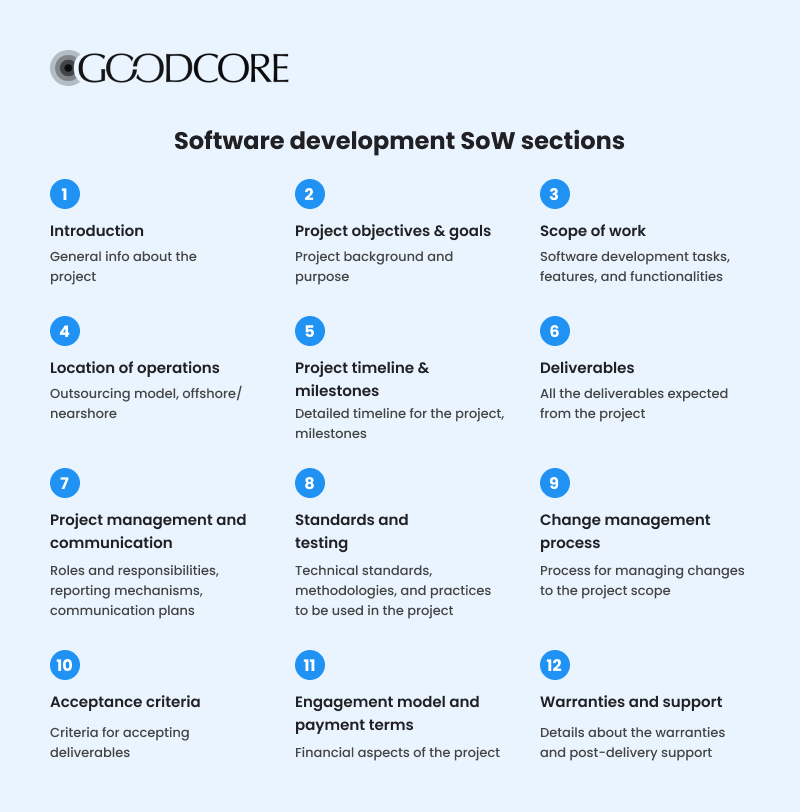
The formats and styles of a SoW document can vary depending on the project and the provider but there are key sections that are commonly included and work for most scenarios.
Here are some of these key sections along with a hypothetical software development SoW sample broken down into parts to illustrate how the sections we discuss are applied in the context of a software project.
- Introduction: This section sets the stage for the statement of work. It typically includes a brief overview of the project, the parties involved, and the background or context leading up to the project.
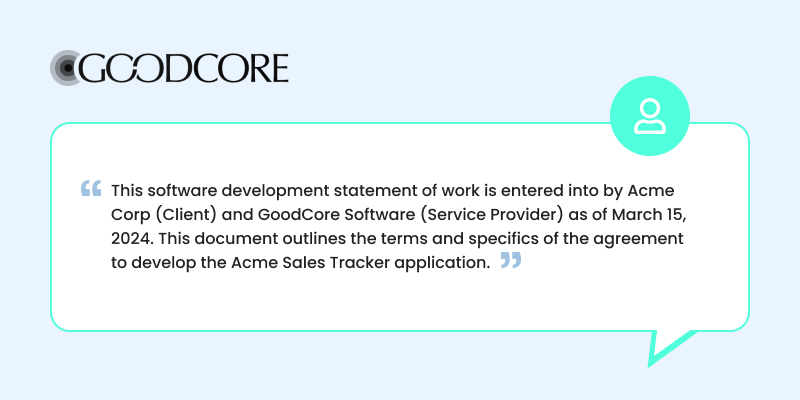
SoW introduction sample - Project objectives and goals: Here, the purpose of the project and the goals to be achieved are specified. This includes both the immediate objectives (such as developing a specific software feature) and broader goals (like improving customer satisfaction or increasing operational efficiency).
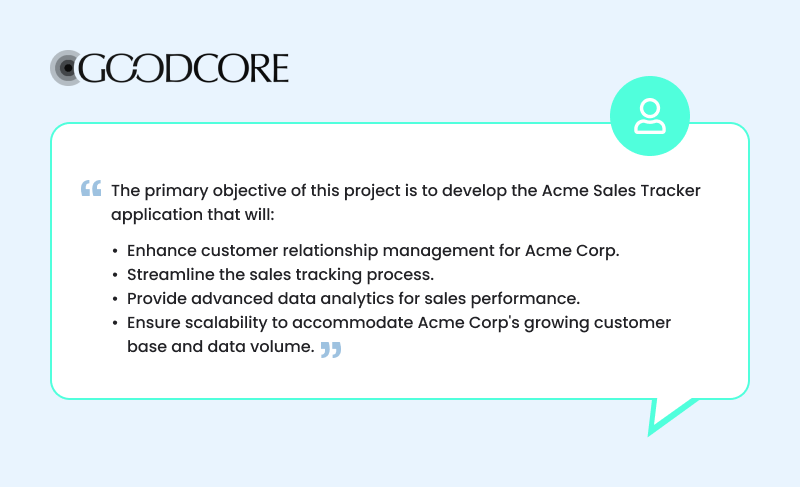
SoW project objectives sample - Scope of work: The project scope statement details the specific activities to be performed. This includes the development tasks, features, and functionalities expected from the project and any key processes to be followed.
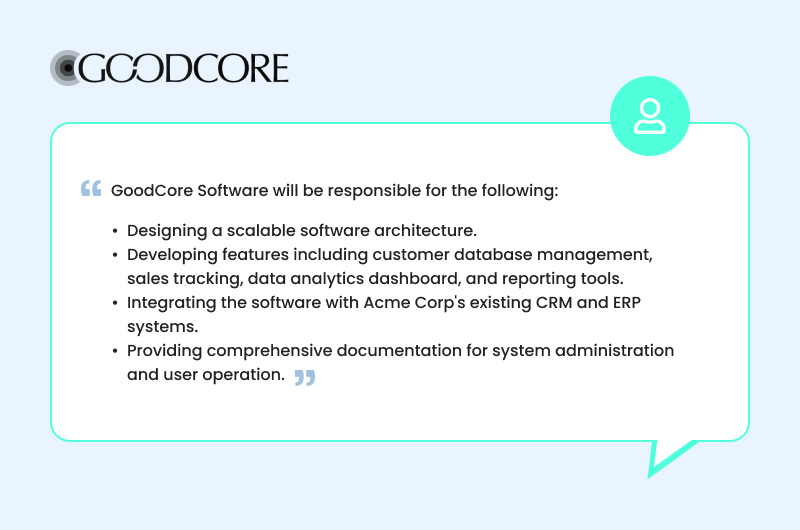
SoW scope of work sample - Location of operations: This part outlines where the work will be carried out. It specifies the outsourcing model, whether the work is to be performed onshore, offshore or nearshore.
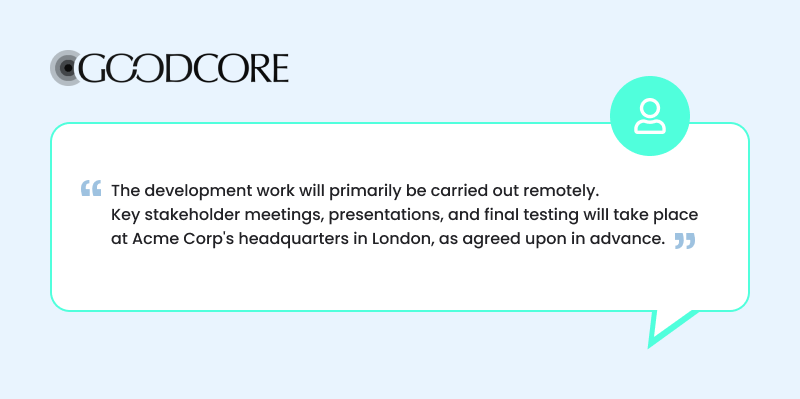
SoW location of operations sample - Project timeline and milestones: This section maps out the detailed timeline for the project schedule, including start and end dates, important milestones and deadlines. Each milestone is typically associated with a specific deliverable or project phase completion.
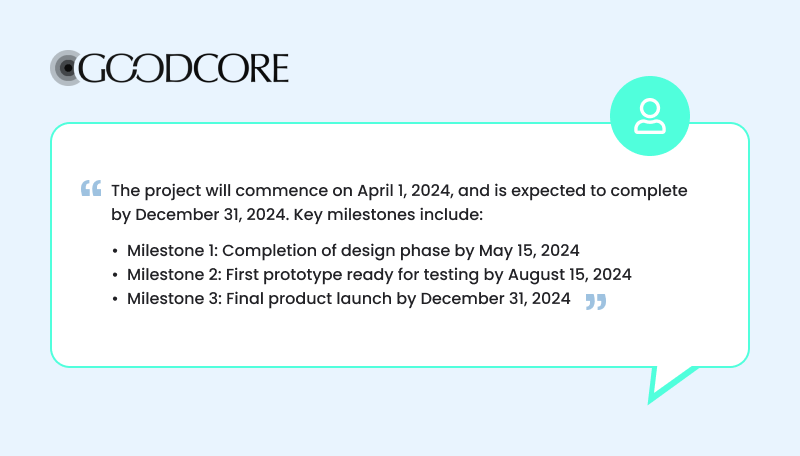
SoW timeline & milestones sample - Deliverables: This section lists all the deliverables expected from the project, including software components, documentation, source code, and any other materials to be delivered upon successful project completion.
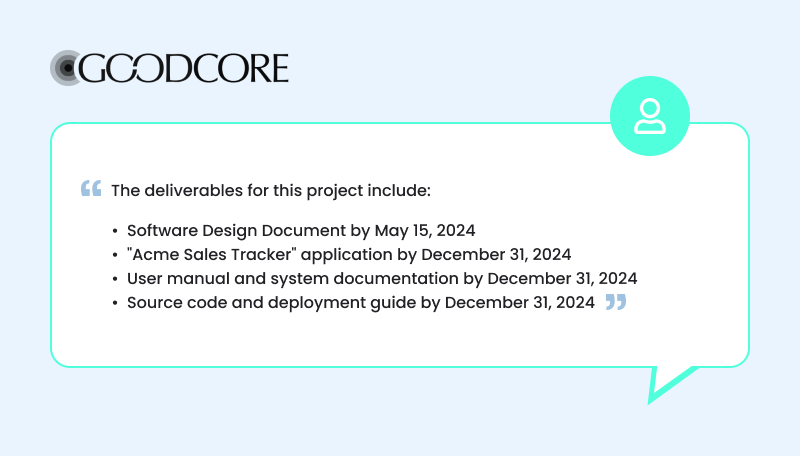
SoW deliverables sample - Project management and communication: Here, the structure for managing the project is outlined, detailing roles and responsibilities and communication plans. It defines how coordination, updates, and decision-making processes will be handled throughout the project.
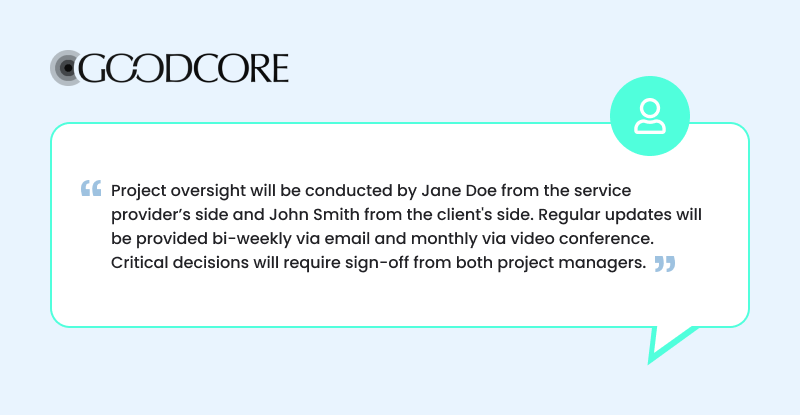
SoW project management & communication sample - Standards and testing: This section describes the technical standards, methodologies, and practices that will be used in the project, such as coding standards, software development lifecycle models, and testing protocols.
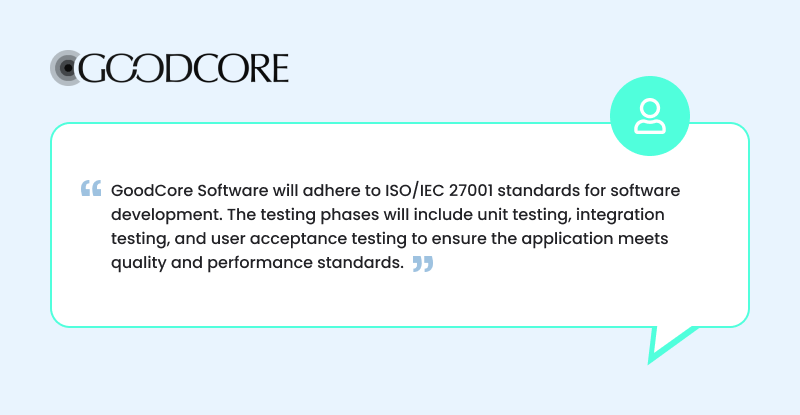
SoW testing & QA sample - Change management process: This part of the SOW outlines how changes to the project scope or deliverables will be managed. It includes the process for requesting, reviewing, approving, and implementing changes, as well as how such changes will impact the budget, timeline, and deliverables.
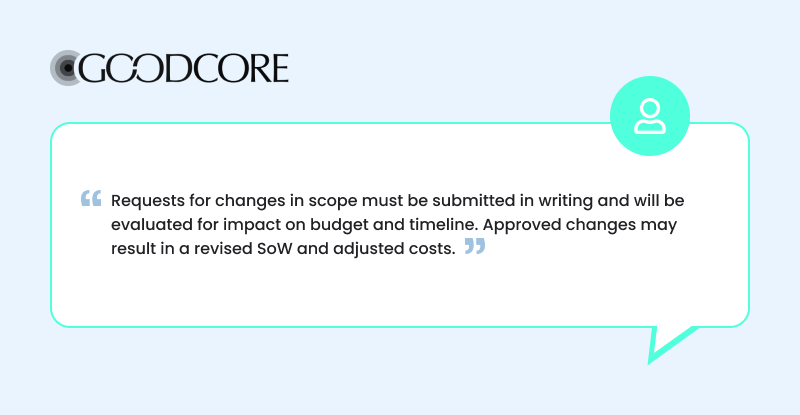
SoW change management sample - Acceptance criteria: Defines the specific criteria that must be met for the deliverables to be accepted. This includes performance benchmarks, quality standards, and functional requirements.
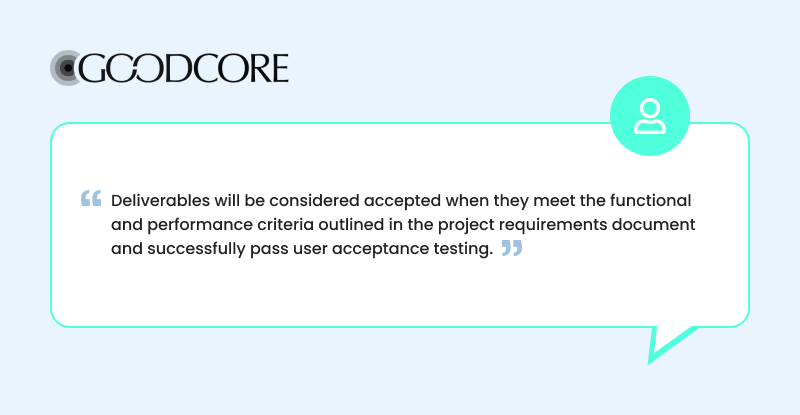
SoW acceptance criteria sample - Engagement model and payment terms: This section describes the nature of the engagement (e.g., fixed-price, time and materials) and the payment schedule. It should detail any milestones linked to payments, invoicing procedures, and terms and conditions related to financial transactions.
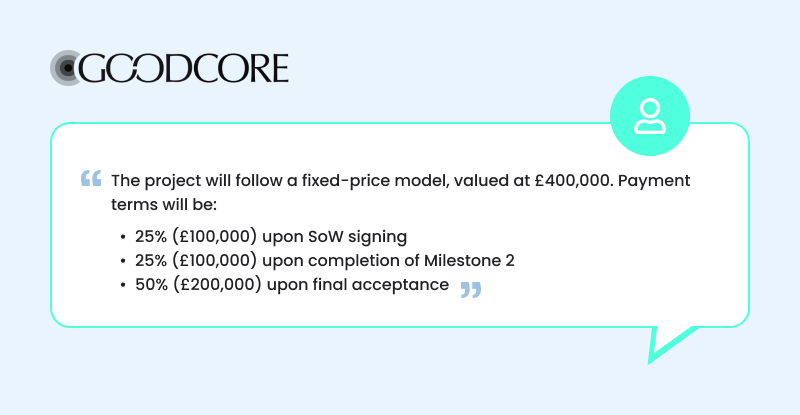
SoW engagement & payment terms sample - Warranties and support: Details any warranties provided with the deliverables, including the duration and scope of such warranties. It also outlines the post-delivery support services, such as maintenance and updates.
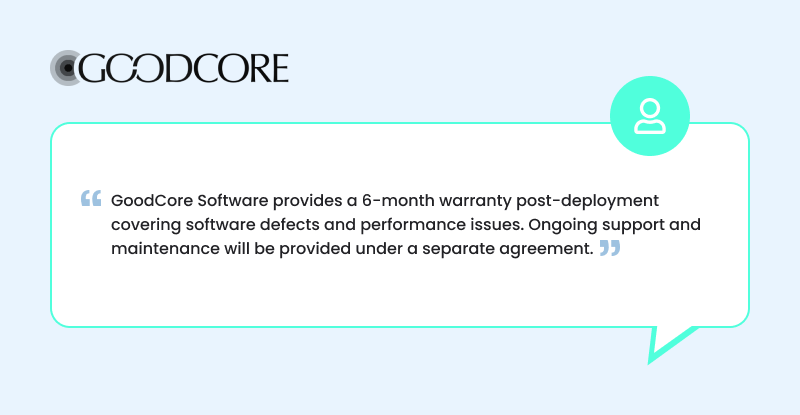
SoW warranties & support sample - Miscellaneous: This catch-all category can include any other terms and conditions not covered in other sections. It might cover legal clauses, intellectual property rights, confidentiality agreements and other miscellaneous terms important to the project.
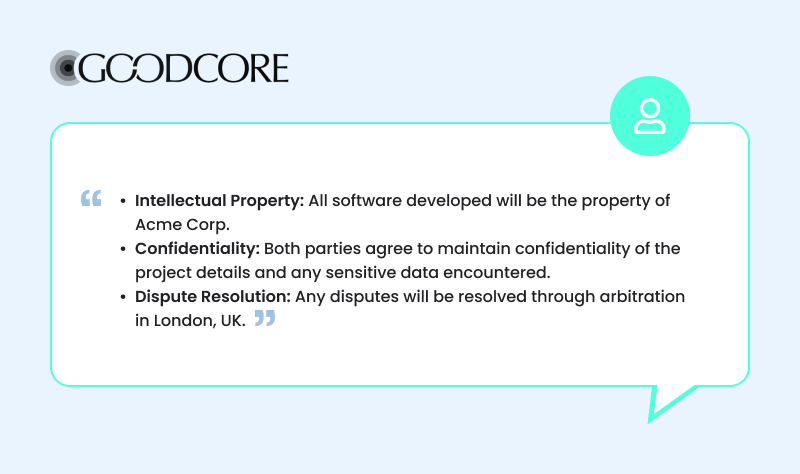
SoW miscellaneous section sample
Now you’ve got a good understanding of SoW in software development, let’s see how you can use this to your advantage to evaluate your software provider’s competency and approach.
How to review a software SoW like a pro
As someone responsible for the success of your project, it’s crucial to evaluate the SoW document not just for its content, but also to gauge your software provider’s competency and approach. Here’s how you can do this:
Clarity and completeness of scope:
- Evaluate if the provider has thoroughly understood your requirements and expectations.
- Look for specific details about the software functionalities, user interface, and performance criteria.
Technical competency and solution approach:
- Assess the technical details outlined in the SoW. Are the proposed technologies and methodologies appropriate?
- Review any proposed frameworks, platforms, or tools for their suitability for your project.
Project management software and methodology:
- Examine how the project will be managed. Look for details on project governance, communication plans, and roles and responsibilities.
- Consider if their approach aligns with your expectations for project management and reporting.
Quality assurance and testing:
- Look for specific testing strategies, standards to be met, and how they plan to address any issues that arise.
- Determine if they have a plan to ensure the software’s functionality, security, and performance.
Budget and payment terms:
- Review the budget breakdown and ensure it is detailed and transparent.
- Understand the payment terms and milestones. Are they reasonable and aligned with project deliverables?
Timeline and milestone planning:
- Assess the feasibility of the proposed timeline. Is it realistic and does it meet your business needs?
- Look at how milestones are structured. Do they allow for regular check-ins and progress tracking?
Change management process:
- Understand how changes to the project scope will be managed.
- Ensure there is a clear and fair process for handling scope changes, including any implications on cost and timeline.
Compliance and legal aspects:
- Verify that the SoW addresses any legal and regulatory compliance issues relevant to your project.
- Check for confidentiality, data protection, and intellectual property rights clauses.
References and past work:
- While this might not be in the SoW, ask for references or case studies of similar projects they’ve completed.
- Evaluate their past work to gauge their experience and success in delivering similar projects.
Termination clauses:
- Review the conditions under which the SoW or contract can be terminated.
- Understand your rights and obligations in case the relationship needs to be ended prematurely.
Your go-to checklist for SoW evaluation
Here’s a condensed checklist that you can keep handy to review the statement of work of your potential software service provider:
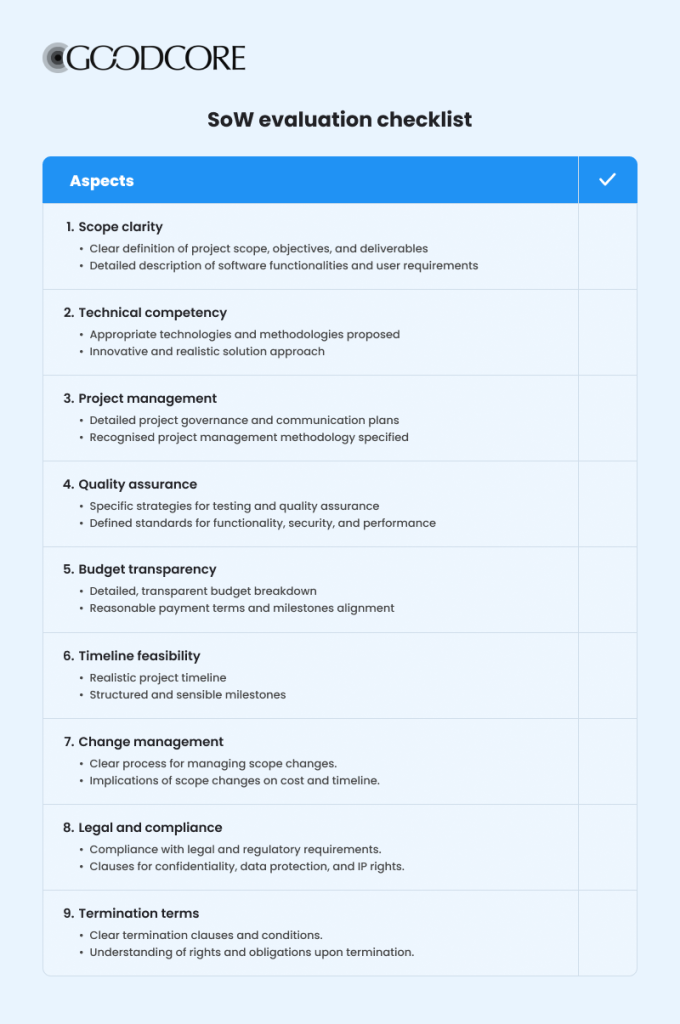
Red flags in SoWs you shouldn’t ignore
When evaluating a statement of work, keep an eye out for certain red flags that can signal potential problems down the line. These warning signs can range from vague descriptions to unrealistic timelines, and spotting them early can save you from hassle later in your project. Here are some red flags in SoWs that you shouldn’t ignore:
- Overly complex or technical jargon: Excessive technical language that makes the SoW hard to understand.
- Inadequate collaboration and involvement: Limited opportunities for your input or oversight in the project. Failure to specify how your feedback will be integrated into the project’s life cycle.
- Unclear ownership of materials and code: Ambiguity about who owns the project deliverables, including source code. No mention of how intellectual property will be handled post-project.
- Hidden costs or fees: Vague references to additional costs, lacking a clear total expense cap or detailed cost breakdown.
- Overprotection of the service provider: Terms that excessively shield the service provider from accountability.
- Mismatch with pre-contract discussions: Significant differences between initial discussions and what is in the SoW.
- Lack of customisation: A generic or template-based SoW that doesn’t address your requirements. Failure to incorporate unique aspects of your business.
Key questions to ask your provider
When discussing the statement of work with your potential software development vendor, you might want to ask some additional questions beyond the standard contents of the SoW to gain a comprehensive understanding of the provider’s work ethic, problem-solving abilities, and approach to client relationships and project management.
Here are some essential questions to consider:
- How do you adapt your strategy when dealing with unforeseen issues or complex project requirements?
- How do you incorporate client feedback throughout the development process?
- What is your process for handling differing opinions or feedback from clients?
- What are your contingency plans for critical situations, like key software development team members leaving the project or technical failures?
- How do you ensure continuity of service in unforeseen circumstances?
The questions listed are just a starting point. As a client, you should feel empowered to ask any additional questions that relate specifically to your project or any aspect that you find ambiguous. Remember, the more informed and involved you are in the early stages, the better the outcome of your project is likely to be.
Have a software development project in mind?
At GoodCore, we pay special attention to creating SoWs that lead your project towards success. Explore how our expertise can benefit your project.
Our software engineering services
FAQs
What is SoW mean in software development?
SoW stands for statement of work. It is a document that clearly outlines the work that will be performed on a specific project. The SoW software includes detailed descriptions of deliverables, timelines, and the scope of work, ensuring that both parties have a clear understanding of the expected outcomes, responsibilities, and metrics for success in a project.
Who writes the SoW for software development projects?
The SoW software is typically written by the service provider, such as a software development company or an independent contractor. The process involves close collaboration with the client to ensure that their requirements and expectations are accurately captured.
How detailed should the software SoW be?
The SoW in software should be detailed enough to clearly define the project’s scope, deliverables, timelines, and specific expectations, while avoiding excessive details. The key is to strike a balance between providing sufficient detail to avoid ambiguity and maintaining flexibility to accommodate reasonable changes or unforeseen challenges that may arise during the project lifecycle.
What are the different types of SoWs for software development?
There are three main types of software development SoW, each catering to different aspects of project management and execution:
Functional SoW: This focuses on the functionalities and features that the software must provide. It details the requirements and specifications that the software must meet, often used when the client knows exactly what they need in terms of functionality.
Performance SoW: This emphasises the performance standards and outcomes the software must achieve. It is less about the specific features and more about the end results or performance criteria the software should fulfill.
Design SoW: This type outlines the design specifications of the software project. It is highly detailed regarding the design elements, user interface, and user experience, often utilised when the design aspects of the software are a primary concern and need to be precisely defined.
Is there a standard software development SoW template, or does it vary by provider?
There is no standard SoW for software development template, as it often varies by provider and the specific needs of the project. Different software development vendors may have their own preferred formats and content inclusions. This variance allows flexibility to tailor the software SoW to the specificities of each project and client-provider relationship.
What is a software development SoW example?
A software development SoW example would typically include sections like project overview, scope of work, deliverables, schedule, payment terms, acceptance criteria, and terms and conditions. Check out the real-time software development SoW example that is shared in the blog post above.





